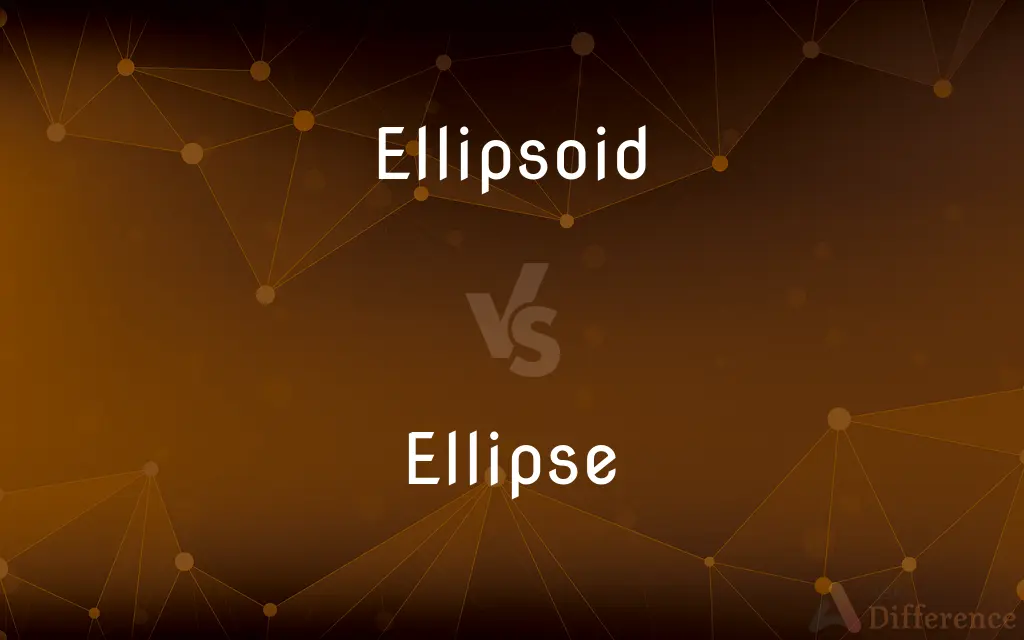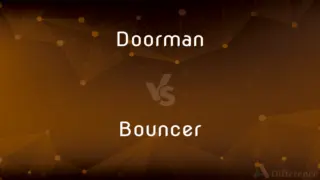Ellipsoid vs. Ellipse — What's the Difference?
Edited by Tayyaba Rehman — By Urooj Arif — Updated on March 8, 2024
An ellipsoid is a 3D shape with elliptical cross-sections, while an ellipse is a 2D, closed curve with two focal points.

Difference Between Ellipsoid and Ellipse
Table of Contents
ADVERTISEMENT
Key Differences
An ellipsoid is a three-dimensional surface, where all cross-sections are ellipses or circles. It extends the concept of an ellipse into three dimensions, offering volume and surface area measurements. Whereas, an ellipse is a two-dimensional shape, defined as the set of points for which the sum of the distances to two fixed points (the foci) is constant.
An ellipsoid, due to its three-dimensional nature, can be used to model and represent real-world objects that are not perfectly spherical, such as planets or human heads. Its three axes allow for a more accurate representation of these objects' dimensions. On the other hand, an ellipse often represents the cross-section of an ellipsoid.
Ellipsoids are defined by three radii, corresponding to the lengths of the semi-principal axes. These axes define the shape and size of the ellipsoid, making it a versatile shape in geometry and physics, especially in representing the earth's shape in geodesy. Ellipses are widely used in physics, engineering, and astronomy, especially to describe the orbits of planets and satellites.
Ellipsoids require three parameters (the lengths of the semi-principal axes) for their complete description, reflecting their three-dimensional complexity. These parameters provide detailed information about the shape's dimensions and how it occupies space. While an ellipse is fully described by two parameters: the lengths of its semi-major and semi-minor axes. This simplicity makes the ellipse easier to study and understand, providing a foundation for exploring more complex shapes like the ellipsoid.
Comparison Chart
Dimensions
3-dimensional
2-dimensional
ADVERTISEMENT
Definition
A surface where all cross-sections are ellipses or circles
A closed curve with two focal points, where the sum of the distances to these points is constant for every point on the curve
Parameters
Defined by three radii (semi-principal axes lengths)
Defined by two axes lengths (semi-major and semi-minor axes)
Applications
Modeling 3D objects in physics and geodesy
Describing planetary orbits, lenses in optics
Shape
Can vary from spherical to highly elongated
Oval shape, varies from circular to elongated
Compare with Definitions
Ellipsoid
A 3D shape with elliptical cross-sections.
An egg can be approximated as an ellipsoid.
Ellipse
A 2D closed curve.
The orbit of Earth around the Sun is an ellipse.
Ellipsoid
Surface area is more complex to calculate.
There's no simple formula for the surface area of a general ellipsoid.
Ellipse
Area can be calculated.
The area of an ellipse is π times the product of its semi-major and semi-minor axes.
Ellipsoid
Volume can be calculated.
The volume formula for an ellipsoid involves its semi-principal axes.
Ellipse
Simpler mathematical properties than ellipsoids.
An ellipse's eccentricity defines its shape.
Ellipsoid
Used in geodesy to model Earth.
Geodesists use ellipsoids to accurately represent Earth's shape.
Ellipse
Used in optics and astronomy.
Ellipses describe the shape of lenses and planetary orbits.
Ellipsoid
Defined by three radii.
Earth is often represented as an oblate ellipsoid.
Ellipse
Defined by two focal points.
The sum of distances from any point on an ellipse to its foci is constant.
Ellipsoid
An ellipsoid is a surface that may be obtained from a sphere by deforming it by means of directional scalings, or more generally, of an affine transformation. An ellipsoid is a quadric surface; that is, a surface that may be defined as the zero set of a polynomial of degree two in three variables.
Ellipse
In mathematics, an ellipse is a plane curve surrounding two focal points, such that for all points on the curve, the sum of the two distances to the focal points is a constant. As such, it generalizes a circle, which is the special type of ellipse in which the two focal points are the same.
Ellipsoid
A geometric surface, all of whose plane sections are either ellipses or circles.
Ellipse
A conic section whose plane is not parallel to the axis, base, or generatrix of the intersected cone.
Ellipsoid
A surface, all of whose cross sections are elliptic or circular (including the sphere), that generalises the ellipse and in Cartesian coordinates (x, y, z) is a quadric with equation x2/a2 + y2/b2 + z2/c2 = 1. Category:en:Surfaces
Ellipse
The locus of points for which the sum of the distances from each point to two fixed points is equal.
Ellipsoid
(geography) Such a surface used as a model of the shape of the earth.
Here the geoid is thirty meters below the ellipsoid.
Ellipse
Ellipsis.
Ellipsoid
Shaped like an ellipse; elliptical.
Ellipse
(geometry) A closed curve, the locus of a point such that the sum of the distances from that point to two other fixed points (called the foci of the ellipse) is constant; equivalently, the conic section that is the intersection of a cone with a plane that does not intersect the base of the cone. Category:en:Curves
Ellipsoid
(mathematics) Of or pertaining to an ellipse; elliptic.
Ellipse
(grammar) To remove from a phrase a word which is grammatically needed, but which is clearly understood without having to be stated.
In B's response to A's question:- (A: Would you like to go out?, B: I'd love to), the words that are ellipsed are go out.
Ellipsoid
(botany) Having the tridimensional shape of an ellipse rotated on its long axis.
Ellipse
An oval or oblong figure, bounded by a regular curve, which corresponds to an oblique projection of a circle, or an oblique section of a cone through its opposite sides. The greatest diameter of the ellipse is the major axis, and the least diameter is the minor axis. See Conic section, under Conic, and cf. Focus.
Ellipsoid
Pertaining to, or shaped like, an ellipsoid; as, ellipsoid or ellipsoidal form.
Ellipse
Omission. See Ellipsis.
Ellipsoid
A surface whose plane sections are all ellipses or circles;
The Earth is an ellipsoid
Ellipse
The elliptical orbit of a planet.
The Sun flies forward to his brother Sun;The dark Earth follows wheeled in her ellipse.
Ellipsoid
In the form of an ellipse
Ellipse
A closed plane curve resulting from the intersection of a circular cone and a plane cutting completely through it;
The sums of the distances from the foci to any point on an ellipse is constant
Common Curiosities
How do the parameters of ellipsoids and ellipses differ?
Ellipsoids are defined by three radii, whereas ellipses are defined by the lengths of their semi-major and semi-minor axes.
Can an ellipse be considered a type of ellipsoid?
No, an ellipse is a 2D shape, while an ellipsoid is 3D, but an ellipse can be a cross-section of an ellipsoid.
Are ellipsoids always symmetrical?
Yes, they are symmetrical about their three principal axes.
Why is the Earth often modeled as an ellipsoid?
Because it more accurately reflects the Earth's shape, accounting for its equatorial bulge.
How are ellipsoids and ellipses used in astronomy?
Ellipsoids model celestial bodies' shapes, while ellipses describe their orbits.
How can an ellipsoid become a sphere?
If all three of its semi-principal axes are equal in length, it becomes a sphere.
What is an ellipsoid?
An ellipsoid is a 3D surface all of whose cross-sections are ellipses or circles, defined by three radii.
What is an ellipse?
An ellipse is a 2D closed curve defined by two focal points, where the sum of distances from any point on the curve to the foci is constant.
How does the eccentricity of an ellipse relate to its shape?
The eccentricity determines how stretched or circular the ellipse is; closer to 0 means more circular.
What are the practical applications of ellipsoids?
In geodesy, to model the Earth, and in 3D modeling of objects in computer graphics.
What is the main difference in calculating the volume or area of an ellipsoid and an ellipse?
The volume of an ellipsoid involves its three axes, while the area of an ellipse involves its two axes.
What are the practical applications of ellipses?
In describing planetary orbits, in optics for lenses, and in engineering for arches.
How does the length of the axes affect the shape of an ellipse?
The ratio of the lengths of the semi-major to semi-minor axes affects its elongation.
Can the area of an ellipse exceed that of a circle?
Yes, if its semi-major axis is sufficiently longer than its semi-minor axis.
Is it easier to calculate the surface area of an ellipse or an ellipsoid?
It's easier to calculate the area of an ellipse due to its simpler 2D nature.
Share Your Discovery

Previous Comparison
Doorman vs. Bouncer
Next Comparison
Brook vs. CreekAuthor Spotlight
Written by
Urooj ArifUrooj is a skilled content writer at Ask Difference, known for her exceptional ability to simplify complex topics into engaging and informative content. With a passion for research and a flair for clear, concise writing, she consistently delivers articles that resonate with our diverse audience.
Edited by
Tayyaba RehmanTayyaba Rehman is a distinguished writer, currently serving as a primary contributor to askdifference.com. As a researcher in semantics and etymology, Tayyaba's passion for the complexity of languages and their distinctions has found a perfect home on the platform. Tayyaba delves into the intricacies of language, distinguishing between commonly confused words and phrases, thereby providing clarity for readers worldwide.















































